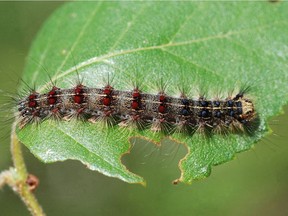Rainstorms helped wash away Norfolk’s gypsy moth threat

Article content
This year’s wet spring and summer in Norfolk County helped area trees and woodlots weather an onslaught of gypsy moth caterpillars.
Foresters warned last year that the invasive species was approaching the peak of its reproductive cycle, setting the stage for potentially devastating impacts on forests in southern Ontario in 2021.
Adam Biddle, supervisor of forests in Norfolk County, says the caterpillars were fast out of the gate this spring. Trees were defoliated in infested areas. But Biddle says they reflushed, in part, due to abundant moisture and moderate temperatures.
“The trees that were defoliated in the spring bounced back pretty good,” he said Aug. 19. “The rain we’ve been getting has been a blessing,”
The moist growing season also aided in the spread of the entomophaga maimaiga fungus. The fungus is a natural check on gypsy moth caterpillars from Japan that was introduced to North America more than 100 years ago when the species became a problem.
Also knocking back the caterpillars was the nuclear polyhedrosis virus, another natural check on gypsy moths that spreads easily when larvae are thick on the ground.
Biddle added that aerial spraying of nearly 2,000 acres of woodlot in Norfolk – 240 of which belongs to the county – with the bacterial agent Bt (bacillus thuringiensis) dealt a third and final blow.
Curbs on the population, Biddle said, caused a slow but steady decline in caterpillar numbers throughout the spring and summer. Biddle said the worst of the infestation appears to be over and Norfolk’s forests should be safe for the time being.
This compares to the last major infestation in Norfolk in 2008. Mature stands of trees were dying back then through a process of continuous defoliation and hot, dry weather.
In response, Norfolk’s forestry division co-ordinated a countywide Bt spraying program. This caused a sudden and precipitous decline in caterpillar numbers. Bt is lethal to gypsy moth caterpillars but doesn’t affect other life forms, plant or animal.
“I do suspect we are over the hump,” Biddle said. “All the signs are there that the caterpillar population is collapsing.”
Norfolk’s forestry division will learn more this fall when staff fan out into the field to perform gypsy moth egg-casing surveys.
Biddle said adult moths were everywhere last summer, as were eggs in waiting. He’s noticed far fewer moths this summer and suspects this will be reflected in the upcoming egg count.
Postmedia is committed to maintaining a lively but civil forum for discussion. Please keep comments relevant and respectful. Comments may take up to an hour to appear on the site. You will receive an email if there is a reply to your comment, an update to a thread you follow or if a user you follow comments. Visit our Community Guidelines for more information.